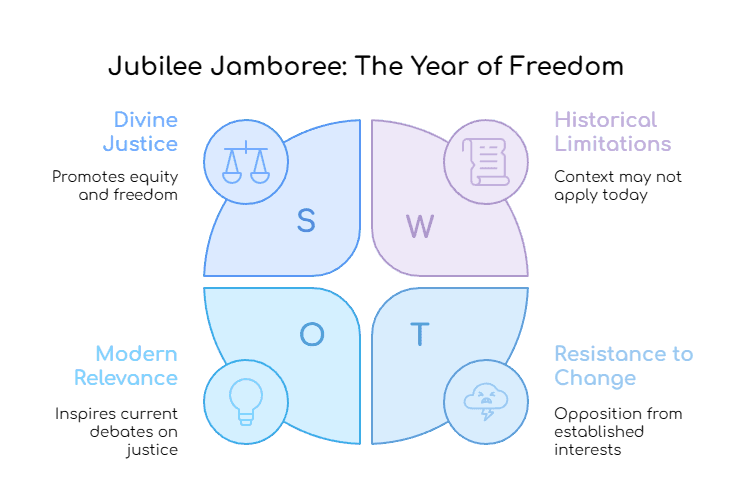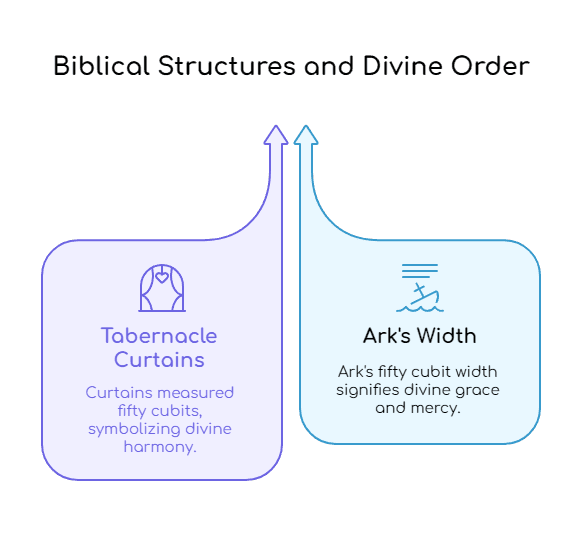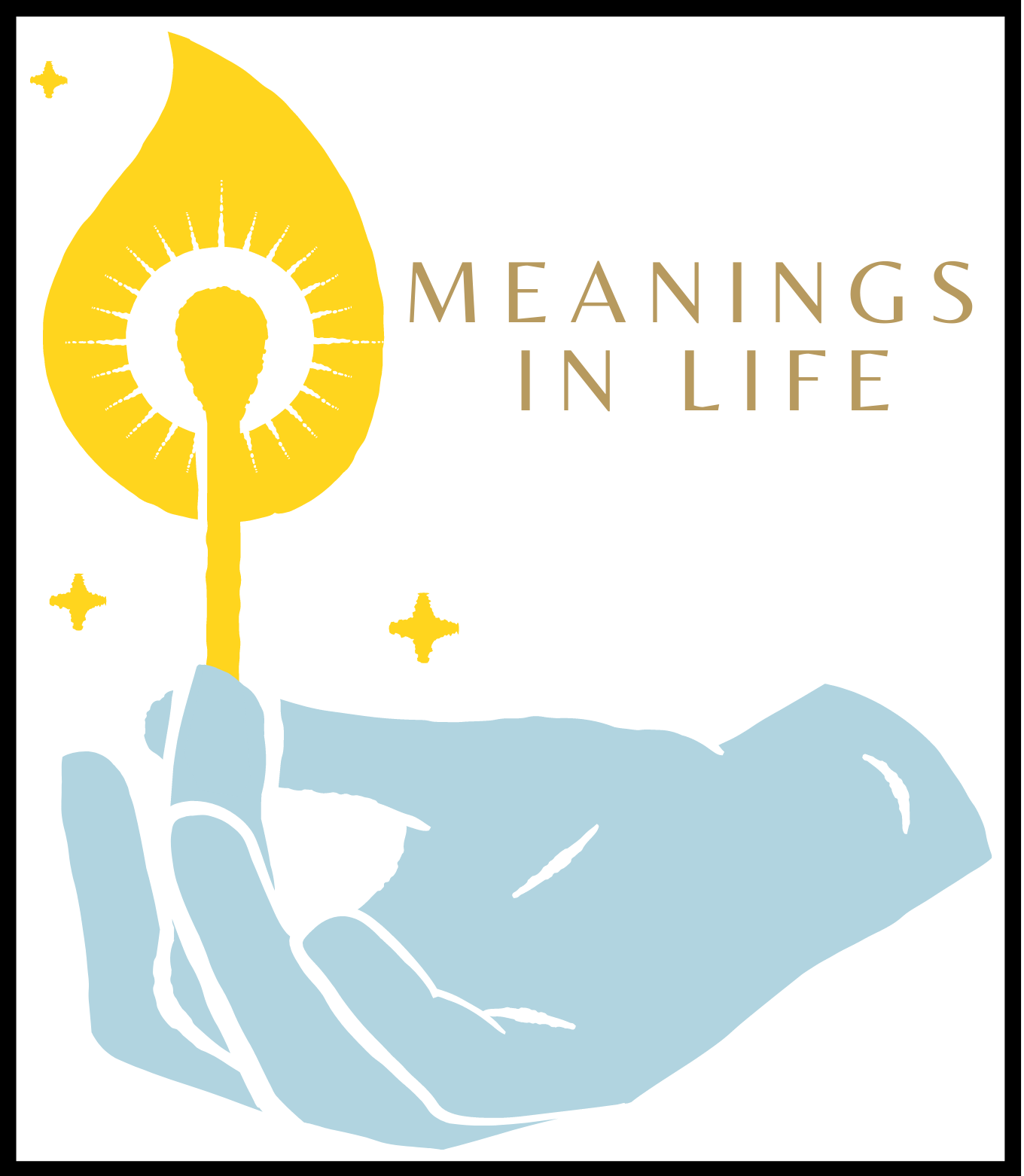Introduction: 50 – Not Just Another Number
A Gentle Foray into Biblical Numerology
Numerology is the belief in the spiritual significance of numbers, and the practice extends its roots deep into antiquity. It was a prevalent concept in many ancient cultures, including that of Mesopotamia, Egypt, China, Greece, and Rome.
However, biblical numerology is quite unique as it carries with it a multitude of meanings deeply intertwined with faith. Biblical numerology revolves around the idea that certain numbers hold divine or prophetic significance.
They serve as coded messages from God to humankind. It’s like a divine Morse code if you will.
Every numeral mentioned in the Bible isn’t accidental; each holds profound symbolic value and is believed to bear a message meant to provide guidance or impart wisdom. The study of these divine digits isn’t just an intellectual exercise; for believers, it’s like being invited to participate in a celestial conversation—an intimate discourse between the Creator and His creation.
The Role Numbers Play in Biblical Narratives
The Bible incorporates an intricate web of numerical references that form part of its essential fabric. These numbers help convey deeper spiritual truths beyond what’s presented at surface level. They’re more than mere mathematical symbols; they carry significant weight within both historical narratives and prophetic visions present in biblical text.
Consider some prime examples: we have seven representing perfection or completeness—visible throughout Scripture—in instances such as God resting on the seventh day after Creation or The Book Of Revelation with its seven seals, seven trumpets, and seven bowls. The number twelve often signifies governmental perfection—it’s no coincidence there were twelve tribes of Israel and Jesus had twelve apostles.
Then there’re those mysterious forty days and nights Moses spent on Mount Sinai, or Christ’s forty-day fast in the wilderness. These instances and many others show that numbers serve as potent symbols in biblical narratives, adding layers of depth and complexity to spiritual teachings.
Embarking on the Journey: Discovering 50
Now that we’ve set a foundation for understanding biblical numerology let’s dive into our central theme: the number 50. Often overlooked, this number occupies a quiet but significant place within biblical text.
It serves as a beacon signaling divine intervention, a mark of jubilation, freedom, and restoration. The number fifty presents itself in fascinating contexts in both Old and New Testaments; from Noah’s Ark dimension to Levitical laws about retirement—each reference speaks volumes about God’s intentions for His people.
Join me as we embark on this captivating exploration of the number 50 across biblical landscapes. As we traverse through tales of jubilee years, Pentecost celebrations, and architectural marvels measured by this numeral—we’ll discover that ’50’ is certainly not just another number; it speaks a language all its own—a language teeming with spiritual significance.
The Big 5-0: Unpacking the Significance

Half a Century: The Biblical Weight of Fifty
When we delve into the intricacies of biblical numerology, we find that the number 50 holds a particular significance. It’s not just another digit or a milestone age. In the realm of spiritual symbolism, it enshrines deeper truths and intriguing mysteries.
The number 50 embodies ideas of freedom, release, and divine intervention within both Old and New Testaments. In biblical terms, fifty represents completeness yet retains an aspect of anticipation for what is to come.
It signifies fullness and completion derived from God’s five-fold grace multiplied by divine order signified by ten – hence fifty. This application is found throughout numerous biblical instances where fifty plays an integral part in demonstrating God’s intervention in human events.
There’s something quite compelling about this number that seems so ordinary yet carries such profound theological weight. In its simplicity, it carries with it layers upon layers of spiritual connotations waiting to be explored and understood.
Where Fifty Flutters: Instances in Scripture
As we leaf through the pages of the Bible, we encounter instances where ‘the big five-o’ makes more than just a cameo appearance; it takes center stage playing pivotal roles in various accounts. One notable example is seen during Elijah’s showdown against false prophets on Mount Carmel (1 Kings 18).
After proving God’s supremacy over all deities worshipped by others around him, Elijah prays for rain to end a seven-year drought – he sends his servant seven times to look for signs of rain clouds before finally spotting one “as small as a man’s hand” (1 Kings 18:44). Notably here is that after being abundantly blessed with showers signaling the end of famine, Elijah runs ahead of King Ahab’s chariot all the way to Jezreel – a distance of about fifty miles, showcasing divine strength.
The number 50 also surfaces in the aftermath of Jesus’ resurrection. In Acts 1:3, we learn that the risen Christ appeared to his disciples over a period of forty days.
But it’s not until ten days after his ascension – making it fifty days since his resurrection – that the Holy Spirit descends upon them during the festival known as Pentecost. These are just some peeks into how ‘fifty’ is ingeniously woven into biblical narratives, each time echoing nuances unique to its usage and signifying divine intervention at specific intervals.
Our journey into understanding this particular numerical significance is far from over. We have only just begun unearthing these treasures buried within the texts.
Jubilee Jamboree: The Year of Freedom

Intricacies of the Jubilee Concept
The concept of Jubilee, taken from the Hebrew word ‘Yobel’, is a fascinating paradigm that originates from ancient Israelite traditions. Put simply, it’s a year-long celebration declared every fiftieth year, a time where debts are absolved, slaves are freed, and lands revert to their original owners.
But there’s more than meets the eye when it comes to this principle. Inherently theological in nature, Jubilee is not merely an antiquated ritual; it’s a profound embodiment of divine justice and mercy.
It serves as an eternal reminder that God is the ultimate owner of land and life. This belief played out literally during the Jubilee year when economic disparities were levelled and societal balance was reset.
The concept also resonates deeply with themes of liberation and redemption prevalent throughout biblical narratives. It echoes God’s deliverance of Israelites from Egyptian bondage, bringing them into a prosperous land “flowing with milk and honey”.
Reveling in Every Fiftieth Year
So how exactly was this auspicious occasion celebrated? According to Leviticus 25:9-10, on the Day of Atonement (Yom Kippur), a shofar–an instrument made from a ram’s horn–would be blown as a declaration announcing the onset of this extraordinary year. This wasn’t just an ordinary annual festivity; it was an entire year dedicated to rest and rejoicing – for people and land alike.
The fields were given respite from sowing or reaping; instead, people were free to eat whatever grew naturally during this time – another reflection on trusting divine providence for sustenance. Amidst these joyous celebrations lay profound societal implications which we’ll delve into within the next section.
Yet, it’s worth noting here that Jubilee years weren’t mere historical events. They continue to reverberate symbolically in contemporary religious observances.
Implications for Societal and Economic Norms
The societal and economic implications of the Jubilee year were profound, radical even by today’s standards. This tradition served as a societal ‘reset button’, mitigating wealth inequality and preventing the perpetual enslavement of individuals fallen into debt.
In an era where slavery was a common practice to repay debts, the Jubilee year provided hope and a guarantee of freedom for those enslaved due to financial hardships. This not only maintained a semblance of equity among communities but also reaffirmed their collective identity as God’s redeemed people.
In terms of economics, returning property to its original owner prevented undue accumulation of land in the hands of few, thus inhibiting extreme socioeconomic disparity. The rich couldn’t become excessively rich at the expense of the poor; instead, this system assured everyone had equal opportunities to start afresh.
Essentially, Jubilee was a divine measure to preserve human dignity and uphold social justice—an astonishing concept when you consider its antiquity! No wonder then that even after thousands of years since its inception, it feels ripe with relevance today inspiring debates on debt cancellation and wealth distribution modern society grapples with.
The Flames of Faith: The Story Behind Pentecost
There’s a powerful narrative etched within the pages of Acts 2 that recounts the remarkable story behind Pentecost. Following Jesus’ crucifixion and resurrection, His disciples were left in a state of trepidation and uncertainty.
But Christ, with His characteristic foresight, had foretold an event that would reshape their lives – the advent of the Holy Spirit. In what could only be described as an ethereal spectacle, the disciples found themselves in a room when a sound akin to a violent wind filled it from heaven.
What followed was an extraordinary sight – tongues resembling fire descended upon each one present there. Each disciple was imbued with the Holy Spirit and began speaking in languages they hadn’t learned – they were bestowed with the gift of tongues.
This riveting episode symbolizes God’s transformative power – shifting fear to courage, confusion to clarity, and followers into fiery apostles. It marked not merely an event but rather the genesis of a new era – one wherein God’s spirit was no longer confined to His temple but dwelt among His people.
The Countdown to Glory: Why Pentecost Is Observed Fifty Days after Resurrection Sunday
The occurrence of Pentecost fifty days after Resurrection Sunday isn’t arbitrary or coincidental but bears tremendous spiritual significance. If we trace our steps back to Jewish tradition, we stumble upon ‘Shavuot,’ also known as ‘Festival of Weeks.’ Shavuot was celebrated seven weeks after Passover (49 days) – interestingly on day 50!
Now let’s steer our attention back towards Christian tradition. Easter Sunday marks Christ’s glorious resurrection following his sacrificial crucifixion on Good Friday (which coincides with Jewish Passover).
Count 50 days from Easter Sunday (inclusive), and you have arrived at Pentecost. This parallel isn’t a mere numerical alignment, but rather a profound metaphorical link – just as Shavuot celebrated the first fruits of harvest, Pentecost marked the first spiritual harvest in the form of three thousand conversions.
The number ’50’ here signifies not just a chronological measure but also encapsulates a spiritual journey from mourning to celebration, death to life, and slavery to freedom – embodying the transformative power of God’s spirit. It’s less about marking time and more about commemorating divine intervention and the spectacular inception of the Church.
Levites at Fifty: Retirement, Biblical Style

A Divine Duty: The Role of Levites in Religious Services
The Levites have a key role in the Bible, especially when it comes to religious ceremonies. They belong to the tribe of Levi and were exclusively selected by God for the day-to-day operations of the sacred Tabernacle and later, the Temple.
Akin to their contemporaries’ priests, their duties involved a range of responsibilities – from maintaining cleanliness within holy precincts to conducting public worship. In contrast with other tribes that received land as their inheritance following Israel’s liberation from Egypt, Levites were awarded with something profoundly spiritual.
Their inheritance was a divine calling – serving God and His people in an intimate way. This unique role solidified their importance within societal structures on a religious level.
The Levites’ purpose was not just confined within religious boundaries; they also served as teachers and judges, guiding Israel through moral quandaries and upholding divine laws. Their influence permeated each aspect of Hebrew life, making them indispensable cogs in the machinery of ancient Israelite society.
Age Is More Than Just a Number: The Retirement Age at Fifty
Despite being chosen for such an esteemed duty that entailed limitless dedication towards servitude, there came a point when Levites had to hang up their ecclesiastical boots. That age was fifty – another biblical instance where 50 carries significance beyond its numerical value. Retirement is often associated with relaxation post years of service; however, this concept held deeper nuances for Levites that transcended beyond mere leisure or rest after laborious service years.
It wasn’t merely an age-related decision; it bore spiritual implications that reverberated within theological conversations about life’s seasons. The divine dictum laid down by God resonates with profound wisdom about human capabilities considering that heavy physical labor was involved in their service.
This age cap reflects an astute understanding and respect for human vitality and fragility. Beyond this point, Levites were allowed to assist their younger brethren, but the strenuous duties were handed over to the next generation.
Why Fifty? Demystifying the Numbers
The intriguing question as to why fifty was chosen as the retirement age opens doorways into a labyrinth of philosophical and theological conjectures. While there is no explicit biblical commentary on why fifty was considered ripe for retirement, some insights can be gleaned through careful interpretation. Taking a detour through numerology might hold some answers.
The number fifty symbolizes liberty and freedom in biblical numerology thus its association with ‘Jubilee Year’. By extension, one could construe that levitical retirement at 50 signaled the onset of a new form of freedom – liberation from rigorous service requirements. Another perspective considers societal realities. In ancient times, living past fifty was quite an achievement given healthcare’s nascent state; therefore retiring at such an age would make sense practically too.
While these interpretations may not provide concrete answers, they certainly add layers of depth to our understanding of why Levites bid adieu to full-time services when they hit 50.
Biblical Building Blocks: Structures with Fifty

Divine Dimensions: The Measurements of the Tabernacle
The Biblical Tabernacle, a transient place of worship and dwelling for the deity was not just a haphazard structure. Every dimension had a precise measurement, and they were all symbolic.
In this sacred space of faith and devotion, the number ’50’ made its significant appearance. The Book of Exodus provides clear instructions on how to construct the Tabernacle, specifying every detail from materials to measurements.
The length of each curtain adorning the Tabernacle was specifically marked as fifty cubits (Exodus 26:8). Similarly, in Exodus 27:12-13 we find that both widths (north and south ends) of the outer courtyard were also accurately set at fifty cubits.
Why fifty? Bible scholars suggest that these precise measurements could be seen as analogies for God’s providence and completeness.
As followers adhered to these divine blueprints, they demonstrated their dedication towards maintaining order within God’s dwelling place. Just like each curtain falling perfectly into place represented harmony in religious assembly.
A Safe Haven at Sea: Noah’s Ark and the Significance of Fifty Cubits
Noah’s Ark was another biblical structure that featured an impressive use of ’50’. This gargantuan vessel that sheltered Noah’s family and all creatures during the Great Flood held more than just literal significance; it was also rich in numerical symbolism. According to Genesis 6:15, Noah’s Ark stretched three hundred cubits in length while its width held at fifty cubits.
This grand sea-craft wasn’t shaped by human whim or architectural prowess but by divine decree – underscoring yet again God’s preference for orderliness. Pondering upon why ‘fifty’ was used here leads us to fascinating theories.
Some theologians propose that the Ark’s width, being ten times five (a number often connected to God’s grace), could signify an amplification of Divine Grace. A colossal demonstration of God’s mercy in sparing Noah and his family from the dreadful deluge.
So, whether it is the meticulous measurements of the Tabernacle or the grandeur of Noah’s Ark, ’50’ emerges as a significant number in biblical architecture. The structures might be different, but they all reverberate with this divine numeric rhythm – encapsulating profound spiritual symbolism within their walls and beams.
Conclusion: More Than Just a Number – It’s a Message
Fifty Shades of Faith: A Biblical Numerology Recap
In our exploration of the number 50 in the Bible, we’ve unraveled many strands of fascinating biblical numerology. We’ve seen how this seemingly innocent number carries with it profound meanings and implications in biblical texts. The jubilee year, marked every fifty years, was a time to reset debts, free slaves, and restore property—a symbol of God’s provision and mercy on His people.
Fifty also denoted the time between Easter and Pentecost—an interval significant for both Christ’s ascension into heaven and the descent of the Holy Spirit upon His disciples. Likewise, we saw how Levites were relieved from their ordained duties at age fifty—signifying a transition into wisdom and mentorship rather than active service.
The Big Five-Oh Finale: Final Thoughts on Biblical Numerology
The symbolism doesn’t stop there! In architecture too, the Bible uses fifty as a building block—the Ark of Noah was 50 cubits wide reminding us that in times of turmoil, there’s always an ark waiting to carry us safely to the other side.
Biblical numerology is an ocean as deep as your curiosity allows you to explore it. It may seem like another layer complicating an already complex text; however, it offers richer insights once we start understanding its patterns.
And remember—numbers are never just numbers in the Bible—they’re carriers of divine messages. As we conclude our journey into biblical numerology focusing on ’50’, let’s part with this thought: Just like every number has its unique significance in the Bible, so do each one of us have unique roles and contributions to make in this grand tapestry called life.
One Last Number: The Final Note
In the end, the number 50 in the Bible is a beacon of hope, freedom, and transition. It’s a testament to how God uses numbers to communicate His divine plans and eternal love for us. So the next time you see ’50’, remember—it’s more than just a number: it’s a divine message worthy of celebration!




